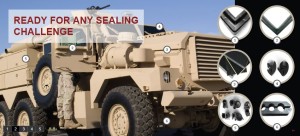 Military gaskets for armored vehicles must account for media, temperature, application, and pressure (MTAP). Defense contractors are familiar with acronyms like MRAP, but gasket designers who include MTAP in their seal designs help support the mission.
Military gaskets for armored vehicles must account for media, temperature, application, and pressure (MTAP). Defense contractors are familiar with acronyms like MRAP, but gasket designers who include MTAP in their seal designs help support the mission.
Clyde Sharpe
General Manager of Elasto Proxy
Have you ever wondered why the military uses so many acronyms? Soldiers, sailors, airmen, and marines need to convey information quickly, accurately, and efficiently. Suppliers to the defense industry are also more likely to hear a term such as “MRAP” than the phrase “mine-resistant ambush-protected vehicle”. For defense contractors who want to do business with military buyers, mastering these acronyms can be learning a new language. The process may be challenging at times, but the rewards are worth it.
Like any specialized discipline, gasket design has its own language, too. For example, many rubber gaskets are made of synthetic elastomers with names such as Buna-N and EPDM. Published specifications such as ASTM D2000 use letters and numbers to “call out” the properties of vulcanized rubber in a highly-structured way. Units of measure such as durometer (hardness) are sometimes unfamiliar, so buyers and designers may need assistance in order to translate the language of rubber into project specifications.
MTAP for Military Gaskets
As an experienced provider of seals, gaskets, and insulation to the defense supply chain, Elasto Proxy specializes in the custom fabrication of low-to-medium volume quantities of high-quality rubber parts. For over 25 years, we’ve worked hard to earn the trust of the North American defense community. Our first customer, Atlantic Defense Industries, was a military contractor that built the boom hoist on a ten-ton truck.
Since then, we’ve supplied the makers of military vehicles with custom-fabricated components such as spliced and molded window gaskets, acoustic and thermal engine bay insulation, and window channels, sealing profiles, and vibration mounts. By listening to our defense industry partners and analyzing all of their needs, we’ve been creating sealing and insulation solutions that can withstand extreme conditions. In the process, we’ve invented an acronym (MTAP) that describes what gasket designers need to consider during compound selection and custom fabrication.
Gasket Media and Temperature
The M in MTAP stands for Media. This includes fuels, chemicals, and any cleaning-type solutions that may be applied. For example, the rubber gasket on a tanker truck’s fuel door must provide gasoline or diesel fuel resistance, depending on the shipment. The window gaskets used in personnel carriers need to resist chemical warfare agents and support decontamination procedures that remove or neutralize these hazardous substances.
The T in MTAP stands for Temperature, another important consideration since this may also limit which rubber materials you can use. If you’re designing a door seal for an armored vehicle, for example, does the military plan to deploy the equipment to environments ranging from Artic cold to desert heat? If so, you’ll need to design the door gaskets with minimum and maximum service temperatures in mind. For other types of rubber products, continuous operating temperature may be a key technical specification.
Gasket Application and Gasket Pressure
The A in MTAP stand for Application, a term to consider carefully since all military applications aren’t the same. If you’re designing rubber gaskets for the doors and windows on military vehicles, do you need to account for specific flange types, flange materials, or fasteners? If the application is bolt-grade, what do the drawings show about the pattern? For example, is it circular and four-bolt? EMI gaskets are different than door seals, and military electronics may require particle-filled shielding silicones.
Finally, the P in MTAP stands for Pressure. Depending on where the rubber gasket will be used, there may be several specifications to consider. If the gasket is designed for use with a metal tank, what is the system or internal pressure? If the rubber seal is for a pump, what’s operating pressure? Maximum pressure is important to specify, too. As with temperature, application, and media, gasket designers need a complete understanding of pressure as a design variable.
Visit Elasto Proxy at CANSEC (Booth #935) | Two Informational Sessions
Do you have questions about how MTAP supports gasket designs? Would you like to learn more about how Elasto Proxy helps defense industry partners meet military program requirements? If you’re headed to CANEC 2015, visit Elasto Proxy in Booth #935 on May 27 or May 28 in Ottawa. Email me to arrange a meeting, and enjoy this short video. It reiterates the main points of this article, so please share it with your defense industry colleagues.








